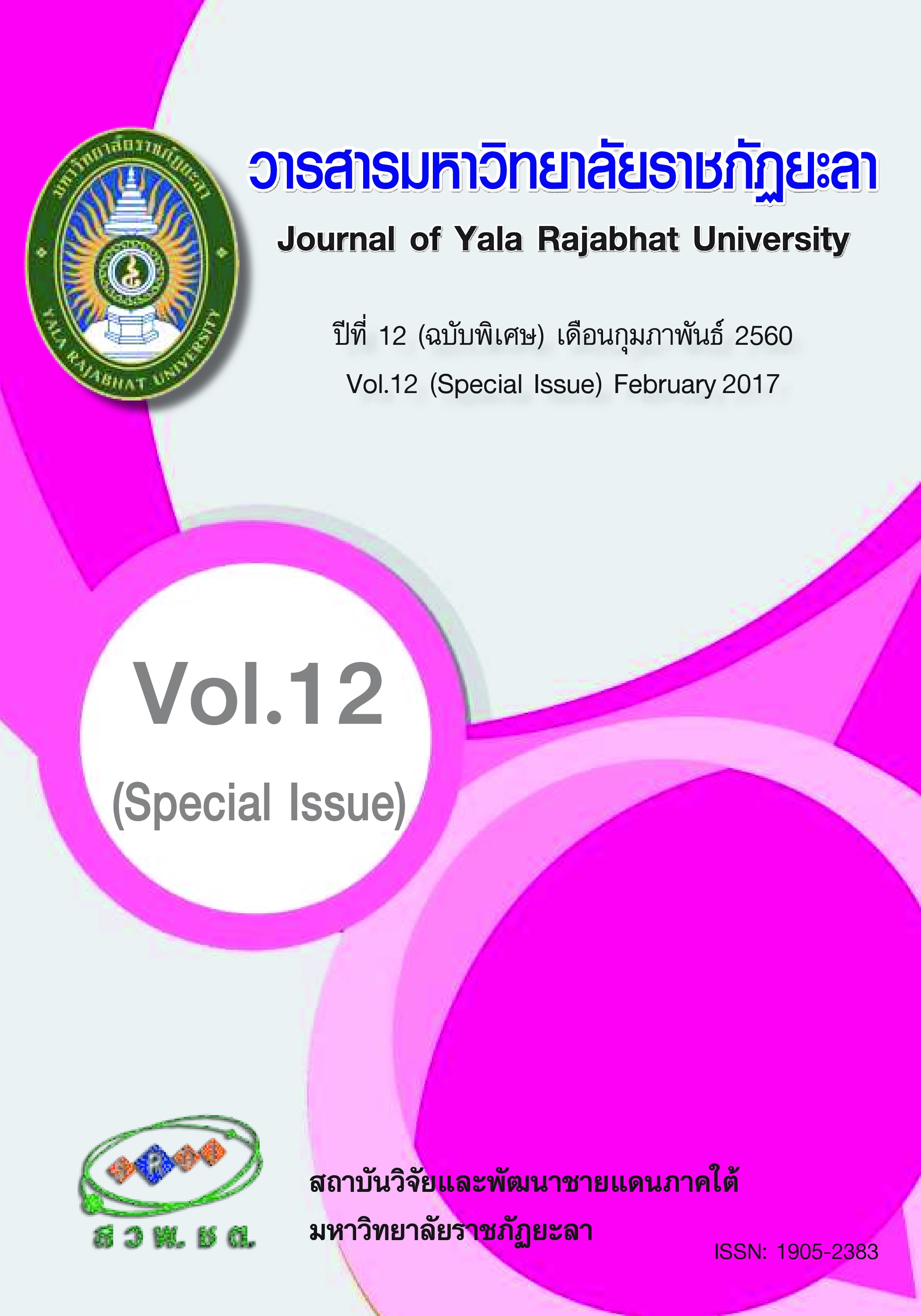การใช้สมุนไพรสปานาโมของผู้บริโภคผลิตภัณฑ์ที่มาซื้อในศูนย์กระจาย ผลิตภัณฑ์ในเขตอำเภอเมือง จังหวัดลำพูน
Main Article Content
บทคัดย่อ
การศึกษานี้เป็นการวิจัยเชิงพรรณนา มีวัตถุประสงค์เพื่อศึกษาความสัมพันธ์ของปัจจัยส่วนบุคคลกับการใช้ผลิตภัณฑ์ของผู้บริโภคผลิตภัณฑ์สมุนไพรสปานาโม เพื่อเปรียบเทียบปัจจัยส่วนบุคคลที่มีความสัมพันธ์กับการใช้ผลิตภัณฑ์ของผู้บริโภคผลิตภัณฑ์สมุนไพรสปานาโม กลุ่มตัวอย่างจำนวน 430 คน สุ่มตัวอย่างอย่างเป็นระบบ โดยใช้แบบสอบถามชนิดถามตอบด้วยตนเอง สถิติที่ใช้ในการวิเคราะห์ข้อมูลได้แก่ ค่าความถี่ ค่าร้อยละ ค่าเฉลี่ย ส่วนเบี่ยงเบนมาตรฐานพร้อมช่วงเชื่อมั่นร้อยละ 95 ทดสอบความสัมพันธ์ด้วยสัมประสิทธิสหสัมพันธ์เพียร์ การทดสอบค่าทีและการวิเคราะห์ความแปรปรวนทางเดียว ผลการวิจัยพบว่า กลุ่มตัวอย่างส่วนใหญ่เป็นเพศหญิงร้อยละ 76.90 โดยเป็นกลุ่มอายุ 36-45 ปี ร้อยละ 43.30 กว่าร้อยละ 53.70 เลือกซื้อผลิตภัณฑ์ประเภทครีมขัดหน้าขัดผิวกาย สถานที่ที่ไปซื้อบ่อยที่สุด ได้แก่ ศูนย์จำหน่ายผลิตภัณฑ์หนึ่งตำบลหนึ่งผลิตภัณฑ์ร้อยละ 41.80 มีการใช้สมุนไพรนาโมโดยรวมร้อยละ 79.50-81.00 โดยนำไปใช้เพื่อการถนอมผิวกายและผิวหน้าโดยการใช้พอกตัวมากที่สุด ร้อยละ 82.50-84.00 การรับรู้ราคามีความสัมพันธ์กับการใช้สมุนไพรนาโมในระดับสูงร้อยละ 91.90 (r=0.91.9, p-value<0.01) รองลงมาได้แก่ การรับรู้สถานที่จำหน่าย ร้อยละ 82.50 (r=0.825, p-value<0.01) ตามด้วยการรับรู้ด้านการตลาดร้อยละ 76.40 (r=0.764, p-value<0.01) ปัจจัยที่มีความสัมพันธ์กับการใช้ผลิตภัณฑ์สมุนไพรสปานาโม ได้แก่ เพศหญิงกลุ่มอายุ 46 ปีขึ้นไป การศึกษาปริญญาตรี ระดับปริญญาโท ส่วนรายได้ตากว่า 10,000 บาท พบความสัมพันธ์เชิงลบ ข้อเสนอแนะควรนำปัจจัยเหล่านี้ ไปพัฒนายุทธศาสตร์วิสาหกิจให้สอดคล้องระหว่างการส่งเสริมสุขภาพกับความยั่งยืน ควรส่งเสริมผลิตภัณฑ์เจาะจงตามกลุ่มที่พบว่ามีความสัมพันธ์ เพื่อส่งเสริมการขายและพัฒนาผลิตภัณฑ์ชนิดใหม่ให้ตอบสนองความต้องการคนกลุ่มนี้มากยิ่งขึ้น พร้อมขยายกรอบแนวคิดในการวิจัยเพิ่มเติมในอนาคต
Article Details
บทความ ข้อมูล เนื้อหา รูปภาพ ฯลฯ ที่ได้รับการเผยแพร่ในวารสารมหาวิทยาลัยราชภัฏยะลานี้ ถือเป็นลิขสิทธิ์ของวารสารมหาวิทยาลัยราชภัฏยะลา หากบุคคลหรือหน่วยงานใดต้องการนำทั้งหมดหรือส่วนหนึ่งส่วนใดไปเผยแพร่ต่อหรือกระทำการใดๆ จะต้องได้รับอนุญาตเป็นลายลักษณ์อักษรจากวารสารมหาวิทยาลัยราชภัฏยะลาก่อนเท่านั้น
เอกสารอ้างอิง
2.Chalermpong, K., Kittiwongsopon, S. & Watthanasirin, S. (2002). Consumer behavior on herbal cosmetics Thailand Women working in Bangkok. Bangkok: Mahidol University. (in Thai)
3.Chokwiwat, W. (2012). Report of the Public Health Thailand. Medical Plan Thailand Folk medicine and alternative medicine. Nonthaburi: Printing WVO. (in Thai)
4.Community Development Department Ministry of the Interior. (2012). Guidelines and criteria for selection of the top. OTOP Thailand BE 2012 (OTOP Product Champion). Bangkok: BTS press Limited. (in Thai)
5.Community forest enterprises. (2014). The application for registration of Community Enterprise cosmetics. Lamphun: the years. (in Thai)
6.Division of Alternative Medicine Thailand Department of Developmental Medicine and Alternative Medicine. (2014). Technical Summary Homeopathy is a therapy Ho Planning and policy development in science Ho Homeopathy. Nonthaburi: Ministry of Health. (in Thai)
7.Chirawatkul, A. (2006). Statistical Test and Calculation of Sample Size in cross-sectional Surveys. Journal of Health Science, 15(6), 823-824. (in Thai)
8.International Spa Association: ISPA. (2008). Direction of World SPA. Accessed Occ 3. Harrodsbug: Lexington, KY.
9.Khupatarut, P. (2007). Marketing Foctors Affecing Decision To Select Day Spa Sevices Of Thai Customer In Mueang Chiang Mai District. Thematic Arts. Chiang Mai University. (in Thai)
10.LelahongJuta, P. (2010). Strategies for Entrepreneur In SMEs to Enter Foreign Markets. Journal of Management, 30(2), 139-144. (in Thai)
11.Lertpiang, S. (2016). Factors Affecting Readiness for ASEAN Economic Community of Accounting Firms, Lampang Province. Journal of Yala Rajabhat University, 11(1), 173-184. (in Thai)
12.Nimmonrat, N. (2005). Factors affecting demand for cosmetics in department stores in Chiang Mai province. Independent Study Program in Economics. Faculty of Economics, Chiang Mai University. (in Thai)
13.Puwittayathorn, T. (2006). Factors affecting the selection of spa in KohSamui Surat Thani. MBA Thesis Business Administration. Surat Thani Rajabhat University. (in Thai)
14.SatKanyarat, S. (2004). Custumer Satisfaction Towards The Marketing Mix of Spa Businesses In Mueang District, Chiangmai Province. Independent Study Master of Business Administration. Chiang Mai University. (in Thai)
15.Wannawongsoun, D. (2001). The adoption of herbal cosmetic products a case study of the Herbal cosmetic products produced by chaophaya abhaibhubejhr hospital in prachinburi province. Master Arts environment. Mahidol University. (in Thai)


